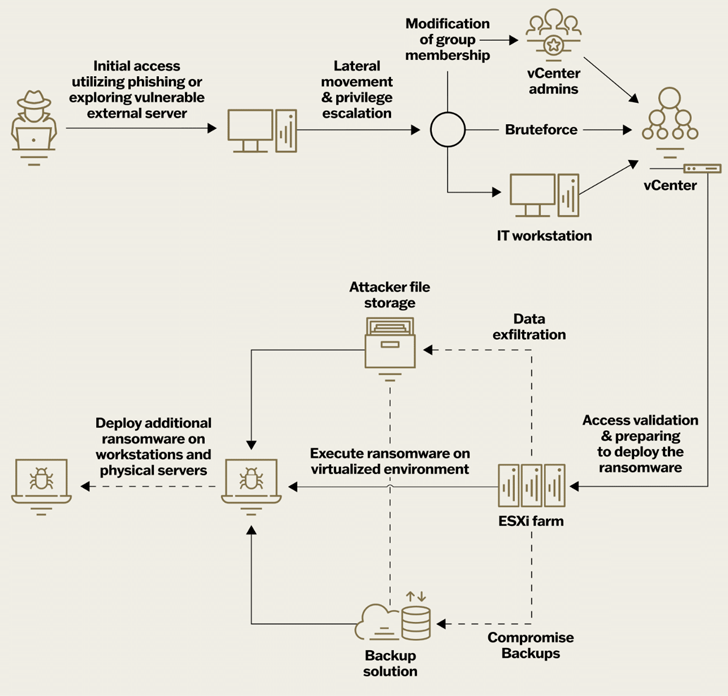
Introduction to Ransomware and VMware ESXi Vulnerabilities
Ransomware attacks have emerged as one of the most pervasive threats to cybersecurity, causing significant disruptions across various industries. These attacks typically involve malicious software that encrypts an organization’s data, rendering it inaccessible until a ransom is paid. In recent times, cybercriminals have increasingly targeted VMware ESXi infrastructure, recognizing its critical role in organizational IT systems. VMware ESXi, a bare-metal hypervisor, enables efficient virtualization by allowing multiple virtual machines (VMs) to run on a single physical server. This capability is vital for businesses aiming to optimize resource utilization and reduce hardware costs.
Given the centrality of VMware ESXi in modern IT environments, it has become an attractive target for ransomware attacks. Cybercriminals exploit vulnerabilities within the ESXi platform, leveraging inherent misconfigurations and unpatched security flaws. The exploitation of these weaknesses can lead to devastating consequences, including the potential compromise of numerous virtual machines hosted on a single server. This amplifies the impact of an attack, making it a lucrative avenue for threat actors.
One of the primary reasons VMware ESXi is susceptible to attacks is the complexity of its configuration. Ensuring the security of a virtualized environment demands meticulous attention to detail, as any oversight can create entry points for attackers. Additionally, the interconnected nature of virtual machines means that a single vulnerability can cascade, affecting the entire infrastructure. Cybercriminals are adept at identifying these weak spots, often using sophisticated techniques to infiltrate and exploit ESXi systems.
The importance of addressing VMware ESXi vulnerabilities cannot be overstated. Organizations must adopt a proactive approach to cybersecurity, regularly updating and auditing their virtual environments to mitigate risks. By understanding the inherent vulnerabilities within VMware ESXi and implementing robust security measures, businesses can better protect their critical assets from the growing threat of ransomware attacks.
Common Ransomware Families Targeting VMware ESXi

Ransomware attacks have increasingly targeted VMware ESXi environments, exploiting specific vulnerabilities to achieve their malicious aims. Among the most notable ransomware families are LockBit, HelloKitty, BlackMatter, RedAlert (N13V), Scattered Spider, Akira, Cactus, BlackCat, and Cheerscrypt. Each of these ransomware types possesses unique characteristics and attack methodologies, making them significant threats to virtualized infrastructures.
LockBit: This ransomware family is known for its highly automated attack process. LockBit exploits unpatched vulnerabilities in VMware ESXi to gain access to virtual machines and encrypt their data swiftly. Its emphasis on speed and automation allows it to spread rapidly across networks.
HelloKitty: Also referred to as FiveHands, HelloKitty targets ESXi servers by leveraging known vulnerabilities to infiltrate and encrypt data. It often uses double extortion tactics, threatening to release stolen data if the ransom is not paid.
BlackMatter: A combination of features from various successful ransomware groups, BlackMatter targets ESXi environments by exploiting weak or default credentials. It is known for its sophisticated encryption algorithms and the ability to disable security mechanisms.
RedAlert (N13V): This ransomware variant specifically targets ESXi servers by exploiting vulnerabilities in the ESXi management interface. RedAlert is notable for its stealthy approach, often remaining undetected until encryption is complete.
Scattered Spider: A relatively new entrant, Scattered Spider focuses on exploiting zero-day vulnerabilities in VMware ESXi. It employs advanced obfuscation techniques to evade detection and maximize damage.
Akira: Known for its targeted attacks on critical infrastructure, Akira exploits ESXi vulnerabilities to gain control of virtual machines. It employs multiple layers of encryption, making data recovery exceptionally challenging without the decryption key.
Cactus: This ransomware targets ESXi environments through phishing campaigns and exploits unpatched vulnerabilities. Cactus is characterized by its use of advanced encryption standards and a focus on exfiltrating sensitive data before encryption.
BlackCat: Also known as ALPHV, BlackCat leverages vulnerabilities in ESXi to deploy its payload. It is distinguished by its customizable encryption methods and the ability to target specific file types within virtual machines.
Cheerscrypt: This ransomware family exploits vulnerabilities in ESXi to gain initial access and deploy its encryption mechanism. Cheerscrypt is known for its detailed ransom notes and the use of multi-threaded encryption to increase the efficiency of its attacks.
These ransomware families demonstrate the diverse and evolving threat landscape facing VMware ESXi environments. Each variant’s unique features and attack methods highlight the importance of maintaining up-to-date security measures and promptly addressing any identified vulnerabilities.
Sequence of Actions in Ransomware Attacks on Virtualization Environments

The lifecycle of ransomware attacks targeting virtualization environments, such as VMware ESXi, typically follows a structured sequence of actions. Understanding these steps is crucial for improving defenses and mitigating risks. The initial phase often involves gaining access to the target environment. Cybercriminals exploit vulnerabilities within the system, such as misconfigurations or unpatched software, to establish a foothold. This entry point is frequently achieved through phishing campaigns, exploiting known vulnerabilities, or leveraging stolen credentials.
Once inside, attackers focus on escalating their privileges. This step is essential for gaining higher-level access, often involving the exploitation of additional vulnerabilities within the virtualization environment. Privilege escalation allows the attackers to navigate through the system more freely and access critical resources. At this stage, they may deploy various tools to probe the network, identify valuable assets, and map out the infrastructure.
With elevated privileges, the next move involves disabling security mechanisms. Cybercriminals often deactiviate or bypass security controls such as antivirus software, intrusion detection systems, and firewalls. By neutralizing these defenses, they reduce the likelihood of detection and increase the chances of a successful attack. This step is crucial for ensuring the ransomware can execute its payload without interference.
The final and most damaging phase is the deployment of ransomware. Attackers initiate the encryption of files within the virtualization environment, targeting critical data and resources. In the case of VMware ESXi, this often means encrypting virtual machine files, which can cripple an organization’s operations. The encryption process is designed to render data inaccessible until a ransom is paid, typically in cryptocurrency. The attackers then leave a ransom note, demanding payment in exchange for the decryption key.
By following this structured sequence of actions, cybercriminals can effectively compromise virtualization environments and cause significant disruption. Awareness of these common patterns is essential for organizations to enhance their security measures, detect early signs of an attack, and implement effective response strategies.
Mitigation Strategies and Best Practices
Mitigating ransomware attacks on VMware ESXi infrastructure requires a multifaceted approach that encompasses regular updates, proper configuration, and robust security measures. One of the most critical steps is ensuring that all virtualization platforms are consistently updated with the latest patches. Regular updates and patch management can significantly reduce the risk of vulnerabilities being exploited by ransomware. It is essential to have a structured patch management process that includes timely updates and thorough testing to ensure compatibility and stability.
Proper configuration and hardening of VMware ESXi environments are also paramount. This involves disabling unnecessary services, applying strict access controls, and setting up secure communication protocols. Hardening guides provided by VMware can be a useful reference to ensure that best practices are being followed. Implementing network segmentation can further enhance security by isolating critical systems, making it more difficult for ransomware to spread across the network. Additionally, using multi-factor authentication (MFA) can add an extra layer of security by requiring multiple forms of verification before granting access to sensitive systems.
Incident response planning plays a crucial role in mitigating the impact of ransomware attacks. Organizations should have a comprehensive incident response plan that outlines the steps to be taken in the event of an attack. This plan should include procedures for isolating affected systems, communicating with stakeholders, and recovering from backups. Regular drills and simulations can help ensure that the response team is well-prepared to handle real incidents efficiently.
Continuous monitoring is another essential component of a robust defense strategy. Employing advanced monitoring tools can help detect unusual activities and potential threats in real-time. By analyzing network traffic, system logs, and user behavior, organizations can identify and respond to suspicious activities before they escalate into full-blown attacks. Combining these strategies with a proactive security posture can significantly enhance the resilience of VMware ESXi infrastructure against ransomware threats.


